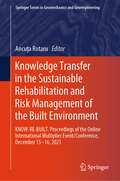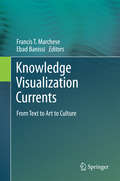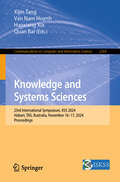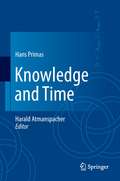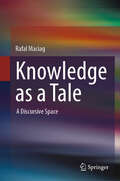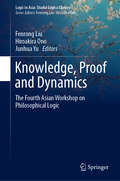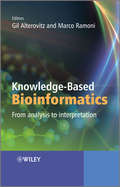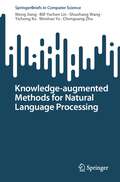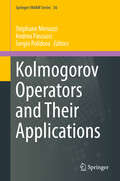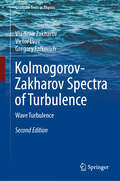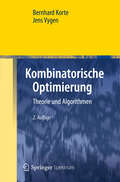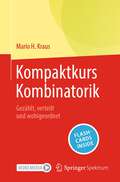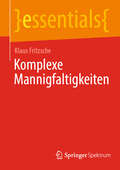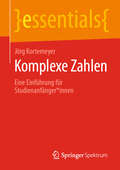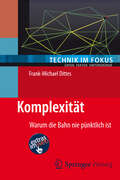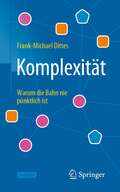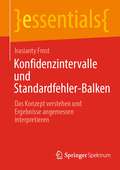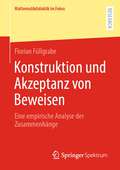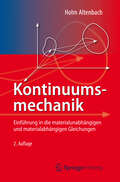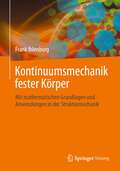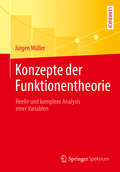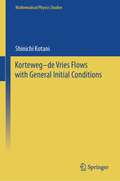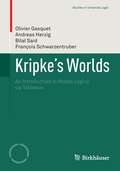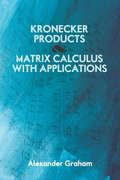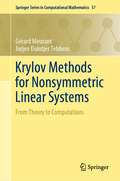- Table View
- List View
Knowledge Transfer in the Sustainable Rehabilitation and Risk Management of the Built Environment: KNOW-RE-BUILT. Proceedings of the Online International Multiplier Event/Conference, December 15-16, 2021 (Springer Series in Geomechanics and Geoengineering)
by Ancuța RotaruThis book showcases the valuable contributions made during the online event entitled The International Conference on Knowledge Transfer in the Sustainable Rehabilitation and Risk Management of the Built Environment. The conference was held on December 15–16, 2021, and was organized as a multiplier event of the European project Rehabilitation of the Built Environment in the Context of Smart City and Sustainable Development Concepts for Knowledge Transfer and Lifelong Learning (RE-BUILT). This book specifically retains the same main themes explored in the book titled Critical Thinking in the Sustainable Rehabilitation and Risk Management of the Built Environment – CRIT-RE-BUILT. The papers included in this book are mostly authored by partners in the project’s consortium and cover various aspects of civil engineering knowledge transfer in crucial areas, to address different perspectives and significant challenges related to the sustainable built environment. The book seeks to provoke ideas and discussions, particularly in the areas where risk management and sustainable rehabilitation of the built environment intersect, ranging from reducing hazard risks to enhancing sustainable rehabilitation efforts in the field
Knowledge Visualization Currents
by Francis T. Marchese Ebad BanissiThis text reviews the evolution of the field of visualization, providing innovative examples from various disciplines, highlighting the important role that visualization plays in extracting and organizing the concepts found in complex data. Features: presents a thorough introduction to the discipline of knowledge visualization, its current state of affairs and possible future developments; examines how tables have been used for information visualization in historical textual documents; discusses the application of visualization techniques for knowledge transfer in business relationships, and for the linguistic exploration and analysis of sensory descriptions; investigates the use of visualization to understand orchestral music scores, the optical theory behind Renaissance art, and to assist in the reconstruction of an historic church; describes immersive 360 degree stereographic visualization, knowledge-embedded embodied interaction, and a novel methodology for the analysis of architectural forms.
Knowledge and Systems Sciences: 23rd International Symposium, KSS 2024, Hobart, TAS, Australia, November 16–17, 2024, Proceedings (Communications in Computer and Information Science #2269)
by Quan Bai Xijin Tang Van Nam Huynh Haoxiang XiaThis book constitutes the refereed proceedings of the 23rd International Symposium on Knowledge and Systems Sciences, KSS 2024, held in Hobart, Tasmania, Australia, during November 16–17, 2024. The 23 full papers presented in this book were carefully reviewed and selected from 50 submissions. They are organized in the following topical sections: Complex networks and modeling; Opinion dynamics; Knowledge technologies and systems engineering; Knowledge management.
Knowledge and Time
by Harald Atmanspacher Hans PrimasThis is a unique volume by a unique scientist, which combines conceptual, formal, and engineering approaches in a way that is rarely seen. Its core is the relation between ways of learning and knowing on the one hand and different modes of time on the other. Partial Boolean logic and the associated notion of complementarity are used to express this relation, and mathematical tools of fundamental physics are used to formalize it. Along the way many central philosophical problems are touched and addressed, above all the mind-body problem. Completed only shortly before the death of the author, the text has been edited and annotated by the author's close collaborator Harald Atmanspacher.
Knowledge as a Tale: A Discursive Space
by Rafal MaciagThis text describes the process that led to knowledge becoming the most important modern good and a complex phenomenon beginning at the end of the 19th century. It was a change in the way of understanding the world proposed by mathematics and geometry. This volume reveals how the paradigm shift, still in progress, is gradually transforming less obvious fields of science, such as the humanities and social sciences while affecting the phenomenon of knowledge. Firstly, meta-analysis gained importance, and secondly, it became natural to perceive knowledge in a social context, showing its diverse and multi-cause dispersion, leading to the phenomenon of knowledge. Due to the interpretation of knowledge as a complex social phenomenon, the author proposes a new model of knowledge description, called the theory of discursive space, making it possible to describe the role and meaning of knowledge as a component of modern civilization that is all-encompassing. This text appeals to students and researchers working in the philosophy of technology.
Knowledge, Proof and Dynamics: The Fourth Asian Workshop on Philosophical Logic (Logic in Asia: Studia Logica Library)
by Fenrong Liu Hiroakira Ono Junhua YuThis volume gathers selected papers presented at the Fourth Asian Workshop on Philosophical Logic, held in Beijing in October 2018. The contributions cover a wide variety of topics in modal logic (epistemic logic, temporal logic and dynamic logic), proof theory, algebraic logic, game logics, and philosophical foundations of logic. They also reflect the interdisciplinary nature of logic – a subject that has been studied in fields as diverse as philosophy, linguistics, mathematics, computer science and artificial intelligence. More specifically. The book also presents the latest developments in logic both in Asia and beyond.
Knowledge-Based Bioinformatics
by Gil Alterovitz Marco RamoniThere is an increasing need throughout the biomedical sciences for a greater understanding of knowledge-based systems and their application to genomic and proteomic research. This book discusses knowledge-based and statistical approaches, along with applications in bioinformatics and systems biology. The text emphasizes the integration of different methods for analysing and interpreting biomedical data. This, in turn, can lead to breakthrough biomolecular discoveries, with applications in personalized medicine.Key Features:Explores the fundamentals and applications of knowledge-based and statistical approaches in bioinformatics and systems biology.Helps readers to interpret genomic, proteomic, and metabolomic data in understanding complex biological molecules and their interactions.Provides useful guidance on dealing with large datasets in knowledge bases, a common issue in bioinformatics.Written by leading international experts in this field.Students, researchers, and industry professionals with a background in biomedical sciences, mathematics, statistics, or computer science will benefit from this book. It will also be useful for readers worldwide who want to master the application of bioinformatics to real-world situations and understand biological problems that motivate algorithms.
Knowledge-augmented Methods for Natural Language Processing (SpringerBriefs in Computer Science)
by Meng Jiang Bill Yuchen Lin Shuohang Wang Yichong Xu Wenhao Yu Chenguang ZhuOver the last few years, natural language processing has seen remarkable progress due to the emergence of larger-scale models, better training techniques, and greater availability of data. Examples of these advancements include GPT-4, ChatGPT, and other pre-trained language models. These models are capable of characterizing linguistic patterns and generating context-aware representations, resulting in high-quality output. However, these models rely solely on input-output pairs during training and, therefore, struggle to incorporate external world knowledge, such as named entities, their relations, common sense, and domain-specific content. Incorporating knowledge into the training and inference of language models is critical to their ability to represent language accurately. Additionally, knowledge is essential in achieving higher levels of intelligence that cannot be attained through statistical learning of input text patterns alone. In this book, we will review recent developmentsin the field of natural language processing, specifically focusing on the role of knowledge in language representation. We will examine how pre-trained language models like GPT-4 and ChatGPT are limited in their ability to capture external world knowledge and explore various approaches to incorporate knowledge into language models. Additionally, we will discuss the significance of knowledge in enabling higher levels of intelligence that go beyond statistical learning on input text patterns. Overall, this survey aims to provide insights into the importance of knowledge in natural language processing and highlight recent advances in this field.
Kolmogorov Operators and Their Applications (Springer INdAM Series #56)
by Sergio Polidoro Andrea Pascucci Stéphane MenozziKolmogorov equations are a fundamental bridge between the theory of partial differential equations and that of stochastic differential equations that arise in several research fields. This volume collects a selection of the talks given at the Cortona meeting by experts in both fields, who presented the most recent developments of the theory. Particular emphasis has been given to degenerate partial differential equations, Itô processes, applications to kinetic theory and to finance.
Kolmogorov-Zakharov Spectra of Turbulence: Wave Turbulence (Graduate Texts in Physics)
by Gregory Falkovich Vladimir Zakharov Victor LvovStarting at the level of graduate students, this book offers a comprehensive introduction to a rapidly developing field of turbulence. It also presents the state of the art of the theory of wave turbulence in diverse media for researchers looking for a formalism to solve existing problems or for new research subjects and ideas. The book provides a general theory of developed wave turbulence in different media: plasmas, solids, atmosphere, oceans and space. The presentation starts with a simple and intuitive dimensional analysis and proceeds to a rigorous analytic theory with exact solutions for the stationary spectra of turbulence, stability theory of such spectra, description of nonstationary regimes and matching spectra with pumping and dissipation regions. The reader is provided with the necessary tools to study nonlinear waves and turbulence: Hamiltonian formalism, statistical description, derivation of kinetics equations and methods of finding their steady and non-steady solutions. In this second edition the book is brought up to date both in theoretical and experimental/observational aspects. In particular, the authors have updated and revised the description of nonstationary turbulence, turbulent entropy production, etc, and added discussions of master equation and several cases of strong turbulence and nonlocal cascades. The book now includes excercises, some with solutions.
Kombinatorische Optimierung
by Jens Vygen Bernhard Korte Rabe Von RandowDas umfassende Lehrbuch zur Kombinatorischen Optimierung beruht auf Vorlesungen, die die Autoren an der Universität Bonn gehalten haben. Sie geben den neuesten Stand des Fachgebiets wieder - mit Schwerpunkt auf theoretischen Resultaten und Algorithmen mit guten Laufzeiten und Ergebnissen. Der Band enthält vollständige Beweise, einige davon wurden bisher nicht in der Lehrbuchliteratur publiziert. Die deutschsprachige Neuauflage enthält alle Ergänzungen und Aktualisierungen der 5. englischsprachigen Auflage, darunter mehr als 60 neue Übungsaufgaben.
Kompaktkurs Kombinatorik: Gezählt, verteilt und wohlgeordnet
by Mario H. KrausDieses Buch ist die erste fachübergreifende Einführung in die Kombinatorik in deutscher Sprache und umfasst Gesetzmäßigkeiten, Rechenregeln, Anwendungen sowie 50 Übungsaufgaben mit Lösungen. Es zeigt, wie dieses oft unterschätzte Fachgebiet zahlreiche Entwicklungen in Linguistik und Lyrik, Mathematik und Informatik, Chemie, Musik, Psychologie, Soziologie und Ökonomie beeinflusste.
Komplexe Mannigfaltigkeiten (essentials)
by Klaus FritzscheNach einer Einführung in die holomorphen Funktionen von mehreren Veränderlichen wird die Welt der komplexen Mannigfaltigkeiten vorgestellt, insbesondere Untermannigfaltigkeiten, analytische Mengen und tangentiale Strukturen. Weitere Themen sind komplexe Vektorbündel, Liegruppen und Quotientenstrukturen. Wichtigste Beispiele sind die Steinschen Mannigfaltigkeiten, sowie die projektiv-algebraischen Mengen mit ihrer Beziehung zur algebraischen Geometrie.
Komplexe Zahlen: Eine Einführung für Studienanfänger*innen (essentials)
by Jörg KortemeyerKomplexe Zahlen sind ein typisches Thema mathematischer Grundlagenveranstaltungen. Dieses Essential liefert eine ausführliche Einführung und Darstellung wesentlicher Aspekte beim Umgang mit komplexen Zahlen, zum einen bezogen auf üblicherweise auftretende Aufgabenstellungen und zum anderen eingebettet in mathematische Grundlageninhalte.
Komplexität
by Frank-Michael DittesAnhand von Alltagsbeispielen untersucht der Autor in dem Buch typische Eigenschaften komplexer Systeme. Behandelt wird insbesondere ein Verhaltensmuster, nämlich die Tendenz dieser Systeme, ihre Komplexität zu erhöhen und einen Zustand am Rande zum Chaos einzunehmen. Die Eigenschaften dieses Zustands werden beschrieben und die Reduktion von Komplexität als Weg zur Stabilisierung abgeleitet. Alle Aussagen werden durch mathematische Modelle physikalischer, biologischer und technischer Systeme illustriert, wobei auf Formeln weitgehend verzichtet wird.
Komplexität: Warum die Bahn nie pünktlich ist (Technik im Fokus)
by Frank-Michael DittesAnhand von Alltagsbeispielen untersucht der Autor in dem Buch typische Eigenschaften komplexer Systeme. Behandelt wird insbesondere ein Verhaltensmuster, nämlich die Tendenz dieser Systeme, ihre Komplexität zu erhöhen und einen Zustand am Rande zum Chaos einzunehmen. Die Eigenschaften dieses Zustands werden beschrieben und die Reduktion von Komplexität als Weg zur Stabilisierung abgeleitet. Alle Aussagen werden durch mathematische Modelle physikalischer, biologischer und technischer Systeme illustriert, wobei auf Formeln weitgehend verzichtet wird.
Konfidenzintervalle und Standardfehler-Balken: Das Konzept verstehen und Ergebnisse angemessen interpretieren (essentials)
by Irasianty FrostDieses essential zeigt die korrekte Anwendung von Konfidenzintervallen und hilft, Fehlinterpretationen derselben zu vermeiden bzw. zu erkennen. Auf die mathematischen Tiefen der Statistik wird bewusst verzichtet. Leser lernen in diesem essential den Begriff und die Bedeutung des Konfidenzintervalls im Kontext der dahinterstehenden Idee von Jerzy Neyman (1894-1981) kennen. Beispiele und Abbildungen erleichtern das Erfassen des Konzepts Konfidenzintervall.
Konstruktion und Akzeptanz von Beweisen: Eine empirische Analyse der Zusammenhänge (Mathematikdidaktik im Fokus)
by Florian FüllgrabeEin Anliegen der mathematikdidaktischen Forschung ist die Beschreibung, Diagnose und Förderung verschiedener mathematischer Kompetenzen, zu denen auch die Beweiskompetenz zählt. Dieses Anliegen wird durch die in diesem Buch vorgestellte empirische Studie adressiert, indem mit einem Mixed-Methods-Ansatz Zusammenhänge zwischen der Konstruktion und Akzeptanz von Beweisen analysiert werden. Genauer wird analysiert, welche Zusammenhänge zwischen der Performanz bei der Konstruktion von Beweisen und der Beurteilung von Beweisprodukten hinsichtlich der Beweisakzeptanz und dazugehörigen Akzeptanzkriterien existieren. Durch die Ergebnisse der Studie wird ein Beitrag dazu geleistet, den Begriff der Beweiskompetenz besser verstehen zu können.
Kontinuumsmechanik
by Holm AltenbachZiel des Buchs ist es, auf möglichst einfache Weise in die Grundlagen dieses anspruchsvollen Fachgebiets einzuführen. Gegliedert in Abschnitte zum historischen Abriss und zur Tensorrechnung, zu materialunabhängigen und zu materialabhängigen Gleichungen liegt der Schwerpunkt des Buchs bei festen deformierbaren Körpern. Viele Beispiele mit vollständigen Lösungen illustrieren den theoretischen Teil. Geeignet für Studierende im Bereich Maschinenbau und Bauingenieurwesens, Physik und Technomathematik sowie für Forscher und Praktiker in der Industrie.
Kontinuumsmechanik fester Körper: Mit mathematischen Grundlagen und Anwendungen in der Strukturmechanik
by Frank IhlenburgDas Lehr- und Übungsbuch ist im Stil der Standardliteratur zur Technischen/Höheren Mechanik geschrieben und schließt inhaltlich an diese an. Theoretische Zusammenhänge werden mit Beispielen und Grafiken illustriert, dazu Übungsaufgaben mit durchgerechneten Lösungen im Anhang. Zielgruppe sind Studierende des Ingenieurwesens und praktisch tätige Ingenieure werden bei nichtlinearen Finite-Elemente-Simulationen unterstützt. In der Verknüpfung FEM-CAD setzt sich die kontinuumsmechanische Modellierung mit Volumenelementen durch, zudem wird Stahl oft durch nichtmetallische Werkstoffe ersetzt. Die Kapitel zur Materialtheorie tragen diesen Trends Rechnung. Weitere Themen sind Kinematik und Kinetik großer Deformationen sowie mathematische und thermodynamische Grundlagen. Für Elastizität und Plastizität wird jeweils auch das viskose Verhalten diskutiert. Das Materialverhalten bei großen Deformationen wird im Kontext mit der linearen Theorie und einfachen FE-Simulationen erläutert.
Konzepte der Funktionentheorie: Reelle und komplexe Analysis einer Variablen
by Jürgen MüllerIn diesem Lehrbuch wird ein direkter Weg von der reellen Analysis einer Variablen in die Funktionentheorie aufgezeigt. Dabei werden schon klassische Themen der eindimensionalen reellen Analysis (wie die Differenzial- und Integralrechnung) weitgehend aus komplexer Sichtweise dargestellt. Das Ziel ist eine in sich geschlossene Darstellung bis hin zu den Rungesätzen und der Dynamik ganzer Funktionen. Den einzelnen Kapiteln angehängte kurze Abschnitte über Konzepte der Funktionentheorie geben Ausblicke auch in die höherdimensionale Analysis sowie einen Eindruck von deren universeller Bedeutung für die Mathematik. Das Buch ist so aufgebaut, dass Teile auch als Grundlage für ein Seminar genutzt werden können. Somit wird dieses faszinierende Gebiet der Mathematik auch Studierenden zugänglich, bei deren Studiengängen die Mathematik nicht im Zentrum steht und für die ein klassischer Einstieg in die Funktionentheorie daher zu zeitaufwändig wäre. Ihnen wird mit diesem Buch der Schritt in die komplexe Analysis ermöglicht, durch den sie eine Vielzahl von Zusammenhängen erkennen können, die in der reellen Analysis verborgen bleiben.
Korteweg–de Vries Flows with General Initial Conditions (Mathematical Physics Studies)
by Shinichi KotaniLarge numbers of studies of the KdV equation have appeared since the pioneering paper by Gardner, Greene, Kruskal, and Miura in 1967. Most of those works have employed the inverse spectral method for 1D Schrödinger operators or an advanced Fourier analysis. Although algebraic approaches have been discovered by Hirota–Sato and Marchenko independently, those have not been fully investigated and analyzed. The present book offers a new approach to the study of the KdV equation, which treats decaying initial data and oscillating data in a unified manner. The author’s method is to represent the tau functions introduced by Hirota–Sato and developed by Segal–Wilson later in terms of the Weyl–Titchmarsh functions (WT functions, in short) for the underlying Schrödinger operators. The main result is stated by a class of WT functions satisfying some of the asymptotic behavior along a curve approaching the spectrum of the Schrödinger operators at +∞ in an order of -(n-1/2)for the nth KdV equation. This class contains many oscillating potentials (initial data) as well as decaying ones. Especially bounded smooth ergodic potentials are included, and under certain conditions on the potentials, the associated Schrödinger operators have dense point spectrum. This provides a mathematical foundation for the study of the soliton turbulence problem initiated by Zakharov, which was the author’s motivation for extending the class of initial data in this book. A large class of almost periodic potentials is also included in these ergodic potentials. P. Deift has conjectured that any solutions to the KdV equation starting from nearly periodic initial data are almost periodic in time. Therefore, our result yields a foundation for this conjecture. For the reader’s benefit, the author has included here (1) a basic knowledge of direct and inverse spectral problem for 1D Schrödinger operators, including the notion of the WT functions; (2)Sato’s Grassmann manifold method revised by Segal–Wilson; and (3) basic results of ergodic Schrödinger operators.
Kripke's Worlds
by Olivier Gasquet Andreas Herzig Bilal Said François SchwarzentruberPossible worlds models were introduced by Saul Kripke in the early 1960s. Basically, a possible world's model is nothing but a graph with labelled nodes and labelled edges. Such graphs provide semantics for various modal logics (alethic, temporal, epistemic and doxastic, dynamic, deontic, description logics) and also turned out useful for other nonclassical logics (intuitionistic, conditional, several paraconsistent and relevant logics). All these logics have been studied intensively in philosophical and mathematical logic and in computer science, and have been applied increasingly in domains such as program semantics, artificial intelligence, and more recently in the semantic web. Additionally, all these logics were also studied proof theoretically. The proof systems for modal logics come in various styles: Hilbert style, natural deduction, sequents, and resolution. However, it is fair to say that the most uniform and most successful such systems are tableaux systems. Given logic and a formula, they allow one to check whether there is a model in that logic. This basically amounts to trying to build a model for the formula by building a tree. This book follows a more general approach by trying to build a graph, the advantage being that a graph is closer to a Kripke model than a tree. It provides a step-by-step introduction to possible worlds semantics (and by that to modal and other nonclassical logics) via the tableaux method. It is accompanied by a piece of software called LoTREC (www. irit. fr/Lotrec). LoTREC allows to check whether a given formula is true at a given world of a given model and to check whether a given formula is satisfiable in a given logic. The latter can be done immediately if the tableau system for that logic has already been implemented in LoTREC. If this is not yet the case LoTREC offers the possibility to implement a tableau system in a relatively easy way via a simple, graph-based, interactive language.
Kronecker Products and Matrix Calculus with Applications (Dover Books on Mathematics)
by Alexander GrahamEnhanced by many worked examples — as well as problems and solutions — this in-depth text discusses the Kronecker matrix product. Named after a 19th-century German mathematician, Leopold Kronecker, the Kronecker product is an increasingly important and useful matrix operation and an area of matrix calculus with numerous applications. A great deal of information previously only available in specialized and hard-to-find texts and papers is presented here at an undergraduate level.After the preliminaries of an introductory chapter, the treatment proceeds to examinations of the Kronecker product and its applications. An introduction to matrix calculus is followed by further development of the subject, including an application of Kronecker products. Final chapters explore the derivative of a matrix and some applications of matrix calculus. The text concludes with solutions to the problems that appear at the end of each chapter and helpful tables of formulae and derivatives.
Krylov Methods for Nonsymmetric Linear Systems: From Theory to Computations (Springer Series in Computational Mathematics #57)
by Gérard Meurant Jurjen Duintjer TebbensThis book aims to give an encyclopedic overview of the state-of-the-art of Krylov subspace iterative methods for solving nonsymmetric systems of algebraic linear equations and to study their mathematical properties. Solving systems of algebraic linear equations is among the most frequent problems in scientific computing; it is used in many disciplines such as physics, engineering, chemistry, biology, and several others. Krylov methods have progressively emerged as the iterative methods with the highest efficiency while being very robust for solving large linear systems; they may be expected to remain so, independent of progress in modern computer-related fields such as parallel and high performance computing. The mathematical properties of the methods are described and analyzed along with their behavior in finite precision arithmetic. A number of numerical examples demonstrate the properties and the behavior of the described methods. Also considered are the methods’ implementations and coding as Matlab®-like functions. Methods which became popular recently are considered in the general framework of Q-OR (quasi-orthogonal )/Q-MR (quasi-minimum) residual methods.This book can be useful for both practitioners and for readers who are more interested in theory. Together with a review of the state-of-the-art, it presents a number of recent theoretical results of the authors, some of them unpublished, as well as a few original algorithms. Some of the derived formulas might be useful for the design of possible new methods or for future analysis. For the more applied user, the book gives an up-to-date overview of the majority of the available Krylov methods for nonsymmetric linear systems, including well-known convergence properties and, as we said above, template codes that can serve as the base for more individualized and elaborate implementations.
